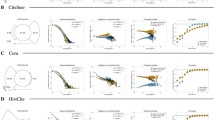Abstract
Six social-science bibliographies were ranked along a complex ordinal dimension of the “homogeneity” of (1) the defining criteria for including items in a bibliography or (2) the disciplinary source(s) of the literature. The most homogeneous bibliography exhibited the classic linearity of the graphic form of Bradford's Law, but the most heterogeneous bibliographies exhibited concavity in their graphic display. The lower the overall article/journal density in a bibliography, the greater the curvature (concavity) of its Bradford plot. Results were discussed in relation to the generalizability of Bradford's Law and to differences between scholarly practices in the social and natural sciences.
Similar content being viewed by others
Notes and References
S. C. Bradford, Sources of information on specific subjects,Engineering, 137 (1934) 85–86.
R. A. Fairthorne, Empirical hyperbolic distributions (Bradford-Zipf-Mandelbrot) for bibliometric description and prediction,Journal of Documentation, 25 (1969) 319–343.
F. F. Leimkuhler, The Bradford distribution,Journal of Documentation, 23 (1967) 197–207.
Y. S. Chen, F. F. Leimkuhler, Bradford's law: An index approach,Scientometrics, 11 (1987) 183–198.
F. F. Leimkuhler, An exact formulation of Bradford's law,Journal of Documentation, 36 (1980) 285–292.
Y. S. Chen, F. F. Leimkuhler, A relationship between Lotka's law, Bradford's law, and Zipf's law,Journal of the American Society for Information Science, 37 (1986) 307–314.
L. Egghe, Consequences of Lotka's law for the Law of Bradford,Journal of Documentation, 41 (1985) 173–189.
B. C. Brookes, Bradford's law and the bibliography of science,Nature, 224 (1969) 953–956.
L. Egghe, Application of the theory of Bradford's law to the calculation of Leimkuhler's law and to the completion of bibliographies,Journal of the American Society for Information Science, 41 (1990) 469–492.
W. Goffman, T. Morris, Bradford's law and library acquisition,Nature, 226, (1970) 922–923.
B. C. Brookes, Theory of the Bradford law,Journal of Documentation, 33 (1977) 180–209.
B. C. Brookes, Towards informetrics: Haitun, Laplace, Zipf, Bradford and the Alvey programme,Journal of Documentation, 40 (1984) 120–143.
D. de Solla Price, A general theory of bibliometric and other cumulative advantage processes,Journal of the American Society for Information Science, 27 (1976) 292–306.
But seeBrookes, “Towards informetrics,” pp. 128–130, as well as pp. 381–382 ofP. T. Nicholls, Bibliometric modeling processes and the empirical validity of Lotka's Law.Journal of the American Society for Information Science, 40 (1989) 379–385.
Brookes, “Bibliography of science;” cf. p. 45 ofM. C. Drott, Bradford's law: Theory, empiricism and the gaps between,Library Trends, 30 (1981) 41–52.
M. C. Drott, B. C. Griffith, An empirical examination of Bradford's law and the scattering of scientific literature,Journal of the American Society for Information Science, 29 (1978) 238–246.
S. R. Coleman, S. Webster, The decline of a research specialty: Human eyelid conditioning in the late 1960s,Behavior and Philosophy, 18 (1990) 19–42.
S. R. Coleman, S. Webster, The problem of volition and the conditioned reflex, Part II: Voluntary-responding subjects, 1950–1980,Behaviorism, 16 (1988) 17–49.
S. R. Coleman, Contributions to the history of psychology: LXXX. The hyperbolic structure of eminence updated, 1975–1986,Psychological Reports, 68 (1991) 1067–1070.
M. Ash, The self-presentation of a discipline: History of psychology in the United States between pedagogy and scholarship, In:L. Graham, W. Lepenies, P. Weingart (Eds),Functions and Uses of Disciplinary Histories, Dordrecht, Holland, Reidel, 1983, pp. 143–189.
M. Wertheimer, Historical research — Why?, In:J. Brozek, L. J. Pongratz (Eds),Historiography of Modern Psychology, Toronto, Hogrefe, 1980, pp. 3–23.
T. S. Kuhn,The Structure of Scientific Revolutions, Chicago, University of Chicago Press, 1970, 2nd ed. with a postscript (1st ed, 1962).
S. R. Coleman, R. Salamon, Kuhn'sStructure of Scientific Revolutions in the psychological journal literature, 1969–1983: A descriptive study,Journal of Mind and Behavior, 9 (1986) 415–445.
See the method section in:S. R. Coleman, P. Cola, S. Webster, Characteristics of the system of production of history-of-psychology literature, 1975–1986,International Journal of Psychology, 27 (1991) 110–124.
E. Kandel, J. H. Schwartz, Molecular biology of learning: Modulation of transmitter release,Science, 218 (1982) 433–443.
R. F. Thompson, The neurobiology of learning and memory,Science, 233 (1986) 941–947.
W. Goffman, K. S. Warren, Dispersion of papers among journals based on a mathematical analysis of two diverse medical literatures,Nature, 221 (1969) 1205–1207.
E. R. Hilgard, D. E. Leary, G. R. McGuire, The history of psychology: A survey and critical assessment,Annual Review of Psychology, 42 (1991) 79–107.
B. Berelson,Graduate Education in the United States, New York, McGraw-Hill, 1960.
An illustration is provided by classification procedures atPsychological Abstracts in the period we examined. Categories of “History” and “History of Psychology” are used as indexing terms by this abstract journal. Distinguishing the two terms requires attention to the boundary of the discipline of psychology, and the problem is that the boundary has never been precise, single-criterion, and constant. As a result, publications assigned to the first category often appear to be suitable candidates for the second.
G. L. Lewis, The relationship of conceptual development to consensus: An exploratory analysis of three subfields.Social Studies of Science, 10 (1980) 285–308.
L. Hargens,Patterns of Scientific Research: A Comparative Analysis of Research in Three Scientific Fields, Washington, DC, American Sociological Association, 1975.
See pages 143–145 ofS. E. Cozzens, Comparing the sciences: Citation contaxt analysis of papers from neuropharmacology and the sociology of science,Social Studies of science, 15 (1985) 127–153.
D. N. Wood, C. A. Bower, The use of social science periodical literature,Journal of Documentation, 25 (1969) 108–122.
Guide to Reference Books: Covering Material from 1985–1990 (supplement to 10th ed.),R. Balay (Ed.), Chicago, American Library Association, 1992; reference to p. 111.
J. van Meurs,Jungian Literary Criticism. 1920–1980, Metuchen, NJ, Scarecrow, 1988.
Author information
Authors and Affiliations
Rights and permissions
About this article
Cite this article
Coleman, S.R. Bradford distributions of social-science bibliographies varying in definitional homogeneity. Scientometrics 27, 75–91 (1993). https://doi.org/10.1007/BF02017756
Received:
Issue Date:
DOI: https://doi.org/10.1007/BF02017756




